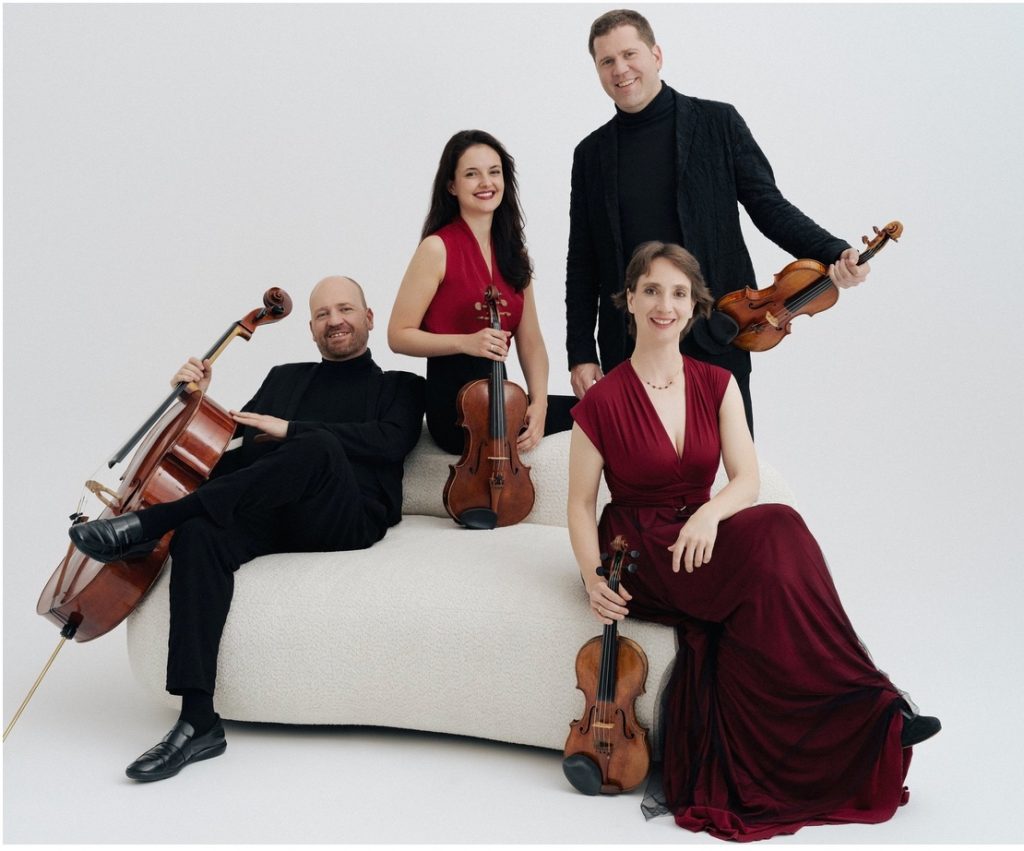by Mike Telin

On Tuesday, November 12 at 7:30 pm at The Cultural Arts Center at Disciples Church, Cuarteto Casals — violinists Abel Tomàs and Vera Martínez, violist Cristina Cordero, and cellist Arneau Tomàs — will return to the Cleveland Chamber Music Society stage with a program that features works by Mozart, Gubaidulina, and Brahms. Tickets are available online.
I caught up with Cristina Cordero and Arneau Tomàs by Zoom in California, where the Quartet was about to begin a U.S. tour. I began our lively conversation by asking for their thoughts on Mozart’s String Quartet in D, “Hoffmeister.”
“What I know is that it is a stand-alone quartet, it’s not part of any cycle,” Tomàs said, adding that Mozart originally intended it to be a string trio. Then, in the middle of the process, the composer decided to turn it into a string quartet. “The Hoffmeister is like the Mozart we know. It’s a beautiful piece because it’s poetically inspired.”
Tomàs noted that the work deserves to be played more often. “It’s a pity because it’s a very nice and interesting piece.”
Why is it called Hoffmeister? “He was Mozart’s friend and editor,” Cordero said, adding, “if you like Mozart, you will like this quartet.”
It’s a well-known fact that Brahms had difficulty when it came to writing string quartets. “Brahms was a lover of the string quartets by Beethoven,” Tomàs said. “But he was so picky and self-demanding that he destroyed most of the ones he wrote.”
Although the Opus 51 in c minor is the composer’s Quartet No. 1, Cordero said it just as well could be his ninth quartet. “A teacher told me that Brahms sometimes said that writing a string quartet was like being in labor, which I always thought was sad because it’s very beautiful music. His string writing reminds me of his piano music — it has so many beautiful melodies that are incredibly Romantic. So I enjoy playing it very much.”
The addition of Sofia Gubaidulina’s Reflections on the Theme B-A-C-H to the Casals’ repertoire came about while they were preparing to record and play Bach’s Art of Fugue to celebrate the ensemble’s 25th anniversary.
“We wanted to include a modern piece of the same musical subject to add some contrast to our programs,” Tomàs said. Cordero noted that the piece is based on the theme in the 18th fugue. “But in a deconstructed way that she does incredibly well, because the theme is so recognizable. It’s very beautiful and exciting to play.”
When asked why they chose Art of Fugue, Tomàs laughed. “We like anniversaries. When we were 15 we did the Schubert cycle, when we were 20 we did the Beethoven cycle. At 25 we wanted to do something not as big but still very nice. Now for our 30th anniversary we’ve decided to play the complete Shostakovich cycle.”
Tomàs said that embarking on the Art of Fugue project was like “going back to the origin of the four-voice construction that is the basic cell of Western music — the soul of our music.”
After 25 years, Cuarteto Casals still includes three of the founding members: Abel Tomàs, Vera Martínez, and Arneau Tomàs. When the group was formed, did they believe it would have such a long life? “Let’s say that it’s something that you start and you don’t exactly know where you will finish,” Tomàs said. “The good thing is that it keeps you in a student mentality, because every new piece that you learn you discover new things. So playing in a quartet is kind of a permanent school for a musician. You go step by step, concert by concert, CD by CD. And then one day you realize, ‘Oh, my God. I’ve been doing this for 25 years.’ But it still feels like the first day. It’s amazing.”
In addition to their busy touring schedule, the Quartet is in residence at the Scuola di Musica di Fiesol, the Koninklijk Conservatorium Den Haag, and at the Escola Superior de Musica de Catalunya in Barcelona. Do they have any words of wisdom for young quartets?
“We have many students who want to follow our steps somehow. I tell them that if you really love this music and you love this genre, then it is something beautiful to do,” Tomàs said. “I also warn them that it’s not easy, because the life of a string quartet player is tough. You have to make many sacrifices. There’s a lot of traveling, a lot of rehearsing, and a lot of working not only on the music, but on the organization of the group, so it’s quite intense.”
Cristina Cordero has a somewhat different perspective. “I joined the quartet only a couple of months ago. I’m 26, so I’m as old as the quartet. But from my experience so far I’m loving it. You do have to make sacrifices but the quartet repertoire is the best. The fact that we can play Bach, Mozart, Gubaidulina, and Brahms on the same concert is insane to me. So it’s really gratifying. And this is the first time I’ve been in the States, and I’m so happy to come to Cleveland with this program. It’s really exciting for us.”
Published on ClevelandClassical.com November 7, 2024
Click here for a printable copy of this article


